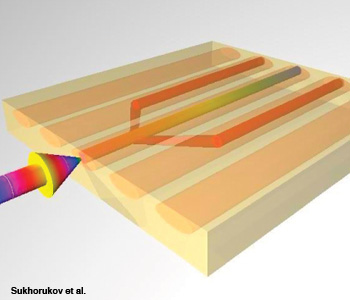
This special issue of Optics & Photonics News (OPN) highlights the most exciting research to emerge in the preceding 12 months in the fast-paced world of optics. “Optics in 2007” offers readers a unique opportunity to access, in a single source, summaries of cutting-edge optics research reported in the peer-reviewed press.
The areas covered in 2007 include biophotonics, communications, holography, lasers, micro-optics, microscopy, nonlinear optics, photonic structures, plasmonics, quantum optics, slow light, solitons and ultrafast optics.
This year’s issue comprises 30 summaries representing the work of more than 120 authors from 13 countries. Submissions were judged on the basis of the following criteria:
• The accomplishments described must have been published in a refereed journal in the year prior to publication in OPN.
• The work should be illustrated in a clear, concise manner that is readily accessible to the at-large optics community.
• The authors should describe the topical area as a whole and then discuss the importance of their work in that context.
Although OPN makes every effort to ensure that achievements in all optics subfields are recognized, there are no requirements in the selection process for inclusion of specific topical areas. When we receive a large number of submissions for a specific area, it is taken as evidence that the topic has been fertile ground for activity and research. OPN strives to ensure that engineering, science and technology are all represented.
OPN and OSA would like to thank all the researchers from around the world who submitted summaries, as well as our panel chair and guest editors.
This year's summaries:
Biophotonics Optics has provided key tools for advancing both modern and traditional biology.
Communications Although there has been a decrease in telecom research since 2000, significant optical engineering advances continue to provide important contributions to wide-bandwidth communications.
Holography Through a careful analysis of numerically reconstructed holographic images, it is possible to obtain 3D information from a single high-aperture EUV Gabor hologram.
Lasers Researchers have demonstrated the optical cooling of a laser.
Micro-Optics What unique performance can be provided by micro-optical systems? Is there a limit to the reduction we can make in optical systems? Researchers have taken steps to address these questions.
Microscopy Microscopy Investigators have found new ways to provide the biological community with more powerful tools.
Nonlinear Optics Phase matching is a necessity, but what happens in the extreme? Can we use the nonlinear processes to create the necessary phase matching?
Photonic Structures The field of photonic structures now includes not only the identification of naturally occurring structures and the production of conventional optical operations, but the observation of disordered optical structures.
Plasmonics Surface plasmons are finding interesting applications in nano-optics, where the attenuation does not dominate.
Quantum Optics Interestingly, quantum optics is being used to solve problems in classical optics.
Slow Light We are finally observing slow light without having to make heroic efforts.
Solitons We can now create structures to form solitons.
Ultrafast Optics Short optical pulses provide useful material processing capability.
Vision A new intraocular lens has been developed to correct coma. Another finding about metamerism shows that the eye-brain connection stills surprises.
